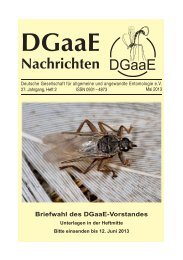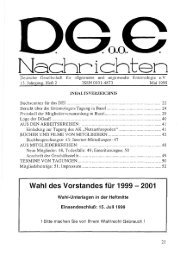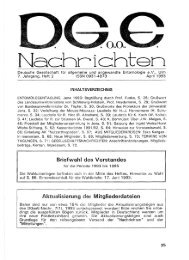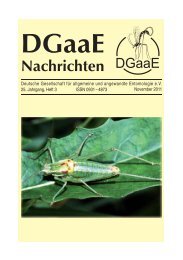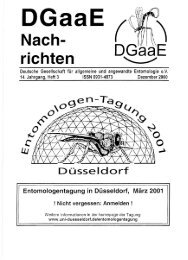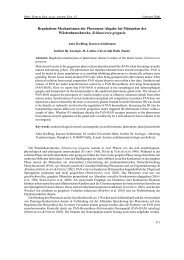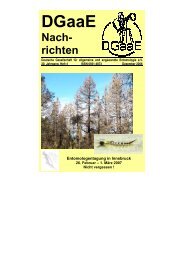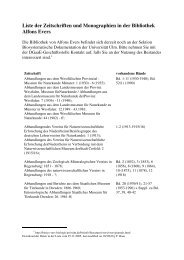Beiträge der Hymenopterologen-Tagung in Stuttgart (1 ... - DGaaE
Beiträge der Hymenopterologen-Tagung in Stuttgart (1 ... - DGaaE
Beiträge der Hymenopterologen-Tagung in Stuttgart (1 ... - DGaaE
Sie wollen auch ein ePaper? Erhöhen Sie die Reichweite Ihrer Titel.
YUMPU macht aus Druck-PDFs automatisch weboptimierte ePaper, die Google liebt.
Beitr. Hymenopt.-<strong>Tagung</strong> <strong>Stuttgart</strong> (2004) 37<br />
e<strong>in</strong>en gemäßigten aber permanenten Räuberdruck auf e<strong>in</strong>zelne Gebiete ausübt. Jedoch beg<strong>in</strong>nen<br />
wir gerade erst e<strong>in</strong>en E<strong>in</strong>blick <strong>in</strong> die Zusammensetzung und Lebensweisen <strong>der</strong> unterschiedlichen<br />
Treiberameisenarten zu gew<strong>in</strong>nen. E<strong>in</strong>gehen<strong>der</strong>e Untersuchungen und neue Herangehensweisen<br />
s<strong>in</strong>d dr<strong>in</strong>gend nötig, um die Frage des Räuberdrucks von Treiberameisen auf e<strong>in</strong>zelne Gebiete<br />
zu klären.<br />
Die Studien wurden <strong>in</strong> enger Zusammenarbeit mit Manfred VERHAAGH (Staatl. Mus. Naturkunde Karlsruhe), K. Eduard<br />
LINSENMAIR (Universität Würzburg) und Ulrich MASCHWITZ (Universität Frankfurt) durchgeführt.<br />
Literatur<br />
BERGHOFF, S.M. 2003: Structur<strong>in</strong>g mechanisms of the hypogaeic army ant Dorylus (Dichthadia) laevigatus FR. SMITH.<br />
— Dissertation, Universität Würzburg. 143 S.<br />
BERGHOFF, S.M., GADAU, J., WINTER, T., LINSENMAIR, K.E. & MASCHWITZ, U. 2003a: Sociobiology of hypogaeic army<br />
ants: characterization of two sympatric Dorylus species on Borneo and their colony conflicts. — Ins. Sociaux 50:<br />
139-147<br />
BERGHOFF, S.M., MASCHWITZ, U. & LINSENMAIR, K.E. 2003b: Influence of the hypogaeic army ant Dorylus<br />
(Dichthadia) laevigatus on tropical arthropod communities. — Oecologia 135: 149-157<br />
FRANKS, N. 1982: Ecology and population regulation <strong>in</strong> the army ant Eciton burchelli. S. 389-395. In LEIGH, E.G.,<br />
RAND, A.S. & W<strong>in</strong>dsor, D.M. (Hrsg.) The ecology of a tropical forest: seasonal rhythms and long-term changes.<br />
— Smithsonian Institution Press, Wash<strong>in</strong>gton<br />
KASPARI, M. & O’DONNELL, S. (2003). High rates of army ant raids <strong>in</strong> the Neotropics and implications for ant colony<br />
and community structure. — Evol. Ecol. Research 5: 933-939<br />
RABELING, C. & VERHAAGH, M. 2002: Erste Erfahrungen mit Palmöl als Kö<strong>der</strong> zum Fang bodenbewohnen<strong>der</strong> Ameisen<br />
<strong>in</strong> Amazonien (Formicidae). — Beitr. Hymenopt. <strong>Tagung</strong> <strong>Stuttgart</strong> [2002]: 58-59<br />
Host recognition <strong>in</strong> the squash bee Peponapis pru<strong>in</strong>osa SAY<br />
(Apidae, Eucer<strong>in</strong>i)<br />
Inge BISCHOFF 1 , James H. CANE 2 & Sarah JORDAN 3<br />
1 Zoologisches Forschungs<strong>in</strong>situt und Museum Alexan<strong>der</strong> Koenig<br />
Adenauerallee 160, D-53113 Bonn, i.bischoff.zfmk@uni-bonn.de<br />
2 Bee Biology and Systematics Laboratory<br />
Logan, Utah, USA<br />
3 Humboldt State University<br />
Arcata, California, USA<br />
Aspects of flower ecology of the squash bee Peponapis pru<strong>in</strong>osa SAY were studied <strong>in</strong> July /<br />
August 2003 at two different squash fields <strong>in</strong> Logan, Utah, USA. Squash bees are solely dependent<br />
upon Cucurbita for pollen and <strong>in</strong> turn are important poll<strong>in</strong>ators of these plants. Cucurbit<br />
flowers are large, showy, and nectar-laden and are readily accessible to, and frequently visited<br />
by, other <strong>in</strong>sects capable of poll<strong>in</strong>ation. Specialized bees are often more proficient than compet<strong>in</strong>g<br />
generalists <strong>in</strong> acquir<strong>in</strong>g pollen from host flowers and this benefit is discussed as one<br />
selective force <strong>in</strong> the evolution of oligolecty. Another advantage of specialists may be better<br />
host recognition. Therefore we analyzed the host recognition of male and female squash bees<br />
with bio-choice experiments to asses the role of visual and olfactory cues of different parts of<br />
the host flowers on the forag<strong>in</strong>g and flower exploit<strong>in</strong>g behavior of the poll<strong>in</strong>ators.<br />
We counted flower visits of male and female bees and documented their behavior at female and<br />
male flowers. The male behavior was classified <strong>in</strong>to four different types (<strong>in</strong>spections, touch<strong>in</strong>g<br />
the flower, nectar prob<strong>in</strong>g, pass<strong>in</strong>g by). The visits of female bees could be divided <strong>in</strong>to nectar




